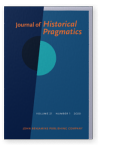Vol. 21:1 (2020) ► pp.83–108
On the diachrony of giusto? (‘right?’) in Italian
A new discoursivization
In Italian, the adjective giusto (‘right’) has performed the discourse function of response marker since at least 1613 (DELI 2008: 671). In this paper, I argue that the adjective has recently undertaken a new process of discoursivization, defined as the diachronic process that ends in discourse (Ocampo 2006: 317). In particular, I maintain that giusto may also serve the function of invariant tag (Andersen 2001), a linguistic item appended to a statement for the purpose of seeking mutual agreement, verification or corroboration of a claim (Millar and Brown 1979). Through diachronic lexicographic, quantitative and qualitative analyses carried out over a range of historical and contemporary dictionaries and language corpora of different varieties, the results will show that, although the use of giusto? as invariant tag is currently undocumented, records of such a use are in fact found since 1990. I explore whether there are positive correlations between the use of right? in English and the use of giusto? in real use Italian and AV dialogues.
Article outline
- 1.Introduction
- 2. Giusto? as an invariant tag
- 3.Methodology and resources
- 4.The analysis
- 4.1Distribution in Italian from 1200 to 1947
- 4.2Distribution in Italian from 1861 to 2017
- 4.3Distribution in spoken Italian
- 4.4Distribution in English from 1600 to 1900
- 4.5Distribution in dubbed Italian
- 5.Conclusions
- Notes
-
References
